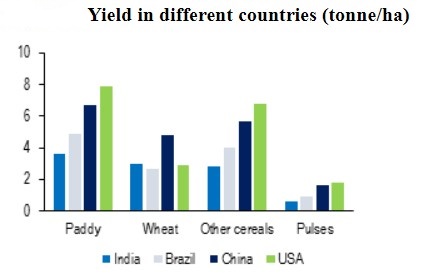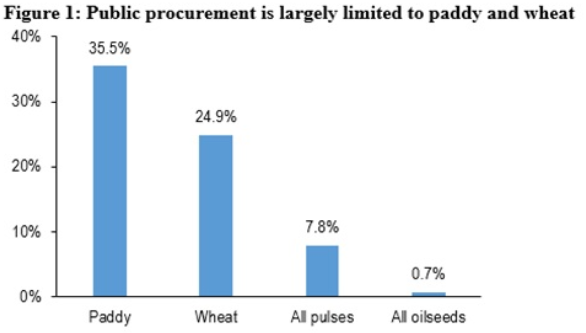Minimum Support Price (MSP)
2023 JUN 20
Mains >
Agriculture > Crops > Agri productivity
IN NEWS:
- Recently, the Cabinet Committee on Economic Affairs approved an increase in minimum support prices (MSP) for Kharif crops with the aim of guaranteeing profitable prices to farmers for their crops and promoting the cultivation of a variety of crops.
MORE ON NEWS:
- Cabinet approved a 10 percent increase in MSP for Moong dal for the new Kharif marketing season. Also, a 9 percent increase in the MSP of groundnuts and a 7 percent increase in paddy have been approved.
- This is the highest growth in MSP for Kharif crops in recent years.
WHAT IS MSP?
- Minimum Support Price is the price set by the government to purchase crops from the farmers. MSP was introduced to give financial stability into the agricultural system and encourage production.
- The MSP is in the nature of an assured market at a minimum guaranteed price offered by the Government.
HOW IS MSP CALCULATED?
- MSP for major agricultural products is fixed by the Department of Agriculture and Co-operation, Government of India, before the sowing season each year.
- The prises are fixed on the basis of recommendations of the Commission for Agricultural Costs and Prices (CACP).
- The CACP is a statutory body and submits separate reports recommending prices for Kharif and Rabi seasons. It considers various factors for the determination of MSPs, such as:
- Cost of production
- Changes in input prices
- Input-output price parity
- Trends in market prices
- Demand and supply
- Inter-crop price parity
- Effect on industrial cost structure
- Effect on cost of living
- Effect on general price level
- International price situation
- Parity between prices paid and prices received by the farmers.
- Effect on issue prices and implications for subsidy
- The CACP calculates cost of production at three levels:
- A2, which includes cost of inputs such as seeds, fertilizer, labour.
- A2+FL, which includes the implied cost of family labour (FL).
- C2, which includes the implied rent on land and interest on capital assets over and above A2+FL.
- Since 2018, MSPs is fixed at 1.5 times of the A2+FL production cost.
- The Central Government after considering the report of CACP and views of the State Governments and also keeping in view the overall demand and supply situation in the country, takes the final decision.
- The Food Corporation of India is the nodal agency for procurement. Several states have also devised their own mechanisms for procurement.
|
In case of sugarcane, MSP has been assigned a statutory status and as such the announced price is termed as statutory minimum price, rechristened as Fair Remunerative Price (FRP). There is statutory binding on sugar factories to pay the minimum announced price and all those transactions or purchase at prices lower than this are considered illegal.
|
CROPS COVERED:
At present, Government announces MSPs for a total of 25 crops and fair and remunerative price (FRP) for sugarcane. They are:
- Cereals (7) - paddy, wheat, barley, jowar, bajra, maize and ragi
- Pulses (5) - gram, arhar/tur, moong, urad and lentil
- Oilseeds (8) - groundnut, rapeseed/mustard, toria, soyabean, sunflower seed, sesamum, safflower seed and nigerseed
- Raw cotton
- Raw jute
- Copra
- De-husked coconut
- Virginia flu cured (VFC) tobacco
- Sugarcane
MSP FOR MINOR FOREST PRODUCE:
- The Central Government had introduced MSP for a select list of MFP in 2011 under the "Mechanism for Marketing of Minor Forest Produce through Minimum Support Price and development of Value chain for MFP" scheme.
- MSP for MFPs is revised once in every 3 years by the Pricing Cell constituted under the Ministry of Tribal Affairs. However, due to the pandemic, the authorities have revised the MSP much earlier than 3 years.
IMPACTS OF MSP:
Positive:
- Assured income: Assured price and direct purchase by the government has resulted in better price realization for farmers and prevented their exploitation by middlemen.
- Insulates farmers: MSP insulates farmers from fluctuation in prices caused by market imperfections, free trade and other elements plaguing the agricultural markets.
- Encourages investments into farm fields: The guaranteed price and assured market encourages higher investment and adoption of modern technologies in agricultural activities.
- Take informed decisions: MSP has become a benchmark for producer, as it helps in estimating the revenue, thereby aiding the financial planning and also influencing borrowing decisions if any.
- Empowers small farmers: Small and marginal farmers with less than two hectares of land account for 86.2% of all farmers in India. Without the MSPs, these farmers, who have neither bargaining power nor expertise for price discovery, will be at the mercy of middlemen and private entities.
- Strengthened buffer stock: MSP has a direct impact on the buffer stock held by the government and the public distribution system. MSP helps the government attract farmers and procure items from them to meet the requirements of the public distribution system.
Negative:
- Altered cropping pattern: The cropping pattern and crop diversity has skewed towards those crops with high MSP and margins. For eg: Pulse growing areas in Central and North India have been taken up by Rice and wheat because of their higher MSP.
- Promotes unsustainable agriculture: The change in cropping pattern and excess focus on monocropping is making agriculture unsustainable. For eg: Paddy production in the semi-arid Punjab plains has adversely affected the groundwater management in the region.
- Encouraged inefficiency: Because of the assured price and procurement, farmers are less interested in improving productivity from their farmlands. For instance, although India ranks third in the production of rice, its yield is lower than Brazil, China and the United States.

- Wastage of produce: Since there are no procurement targets, the state and central agencies procure more than what is required or what they are capable to handle. This results in wastage of crops.
- Creates market distortions: MSP distorts the market because the government procurement agencies buy lion’s share of the produce and thereby force out private players. Also, too much of a hike on MSP paves way for inflationary effects on the economy.
- Fiscal burden: The successive hiking of MSP, coupled with open-ended procurement and heavily subsidized distribution under National Food Security Act (NFSA) has resulted in a ballooning food subsidy budget.
- Political tool: MSP has become part of the vote bank politics in India. As a result, successive governments have focused on hiking MSP rather than addressing structural efforts such as investing in agri-infrastructure, reforming the markets and initiating land reforms.
CHALLENGES:
- Weak public procurement mechanism: The government procurement mechanism varies across the country. In parts of the country where the procurement mechanism is weak, farmers end up selling their produce at a price lower than the MSP.
- Lack of awareness: only 13.5 per cent of paddy farmers disposed of their produce to Food Corporation of India or any other state procurement agency. Only 16 per cent of wheat farmers sold their produce to any procurement agencies. The government should use the money for other productive purposes rather than buying surplus crops.
- Insufficient pricing: Farm activists have argued that the current A2+FL MSP formula is not sufficient to make farming profitable and should have been replaced with the C2 costs.
- Intercrop disparity: Although MSPs are declared for various crops, public procurement is limited to a few crops such as paddy, wheat and, to a limited extent, pulses as shown in Figure 1.

- Regional disparity: The procurement is largely limited to a few states. For eg: Three states which produce 49% of the national wheat output account for 93% of procurement. Also, the actual costing for production varies from place to place, more severely so in areas with lack of irrigation facilities and infrastructure. Thus, not all farmers get equal benefits.
- Lack of awareness: In a report to measure the efficacy of MSPs, the NITI Aayog found that a low proportion of farmers (10%) were aware of MSPs before the sowing season. 62% of the farmers were informed of MSPs only after sowing their crops.
- International disputes: India’s MSP regime has been a major bone of contention under the World Trade Organisation (WTO) because it comes under trade distorting support as per the Agreement on Agriculture.
WAY FORWARD:
- Switch to C2 based MSP: The Abhijit Sen Committee on Long-term Grain Policy and the National Commission on Farmers (NCF) chaired by Professor M.S. Swaminathan had recommended that the MSPs must be based on its projection of the full C2 cost.
- NITI Aayog’s alternatives: NITI Aayog in consultation with state governments has proposed three alternative mechanisms:
- Market assurance scheme: This proposes procurement by government machinery from the farmers at MSP in case farm harvest prices fall below that.
- Price Deficiency payment: Price deficiency payment scheme - Under this scheme if the farmers’ sale price is below a modal price, then the they will be compensated the difference between MSP and actual price.
- Private participation in stockers scheme: This scheme relates to the procurement at MSP by the private entrepreneurs.
- Market reforms: There is a need to transform marketing arrangements for improving market efficiency by strengthening existing institutions, like FPOs, contract farming, cooperatives, and SHGs.
- Adopt modern technologies: Establishing monitoring and forecasting units at the state and national level will help in taking informed decisions well in advance. For this, technologies such as big data analysis and Artificial Intelligence (AI) should be leveraged.
- Encourage sustainable farming: Governments need to encourage crop diversification and efficient farming practices. For this, initiatives such as Pradhan Mantri Krishi Sinchayee Yojana and national mission on sustainable agriculture needs to be leveraged.
- Promote cooperatives: Cooperative agriculture is a key area which can help small and marginal farmers. Governments need to leverage on the success stories of Amul Dairy Cooperative in Gujarat and Kudumbashree programme in Kerala and encourage cooperative farming.
- Invest in long term development: Hiking MSP without investing in infrastructure is just a short-term play. Governments should boost their efforts towards long-term developments, such as irrigation, transport and storage facilities, agri-credit and climate smart agriculture.
PRACTICE QUESTION:
Q. Critically examine the significance of Minimum Support Price (MSP) in addressing India’s agricultural distress?

